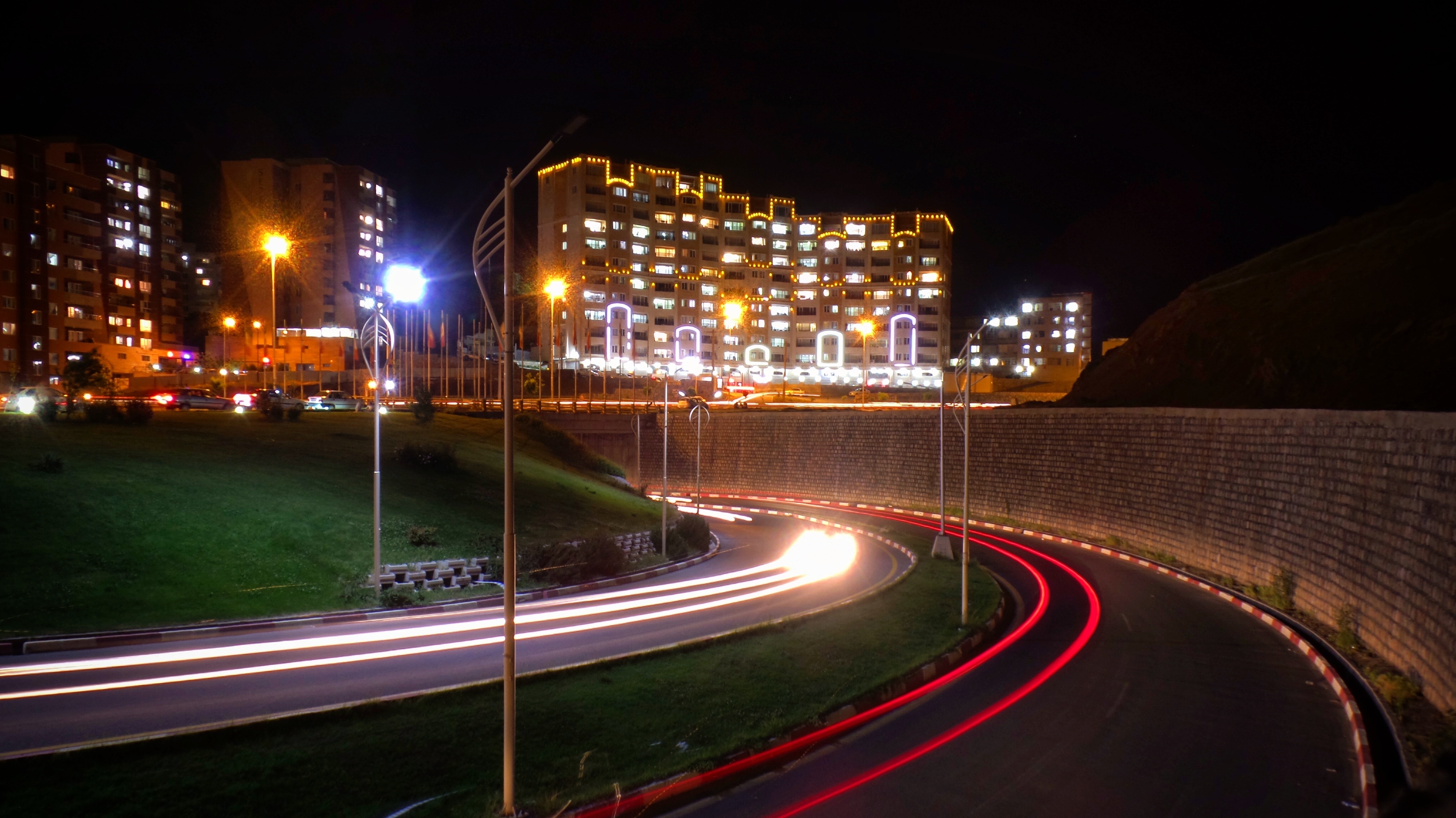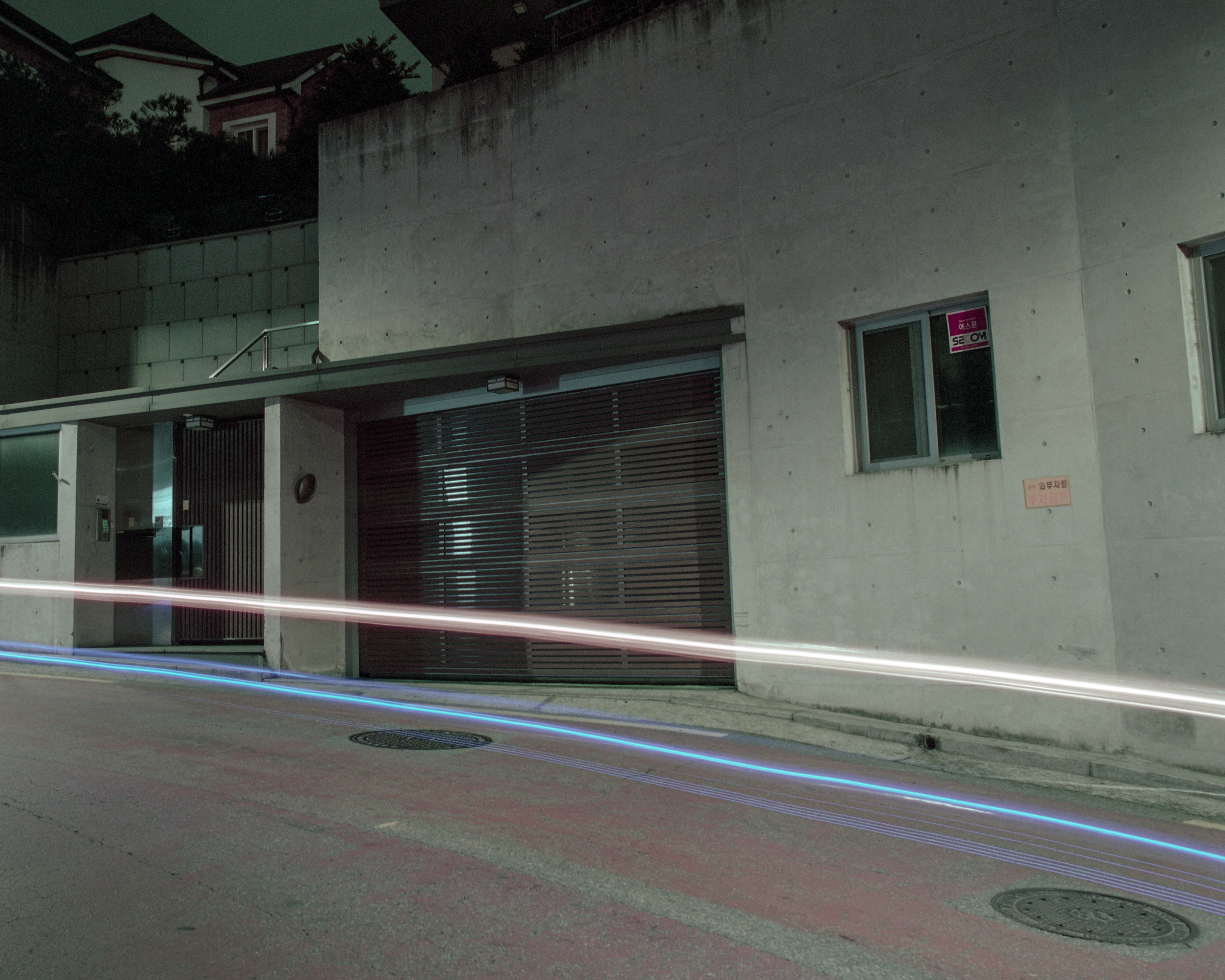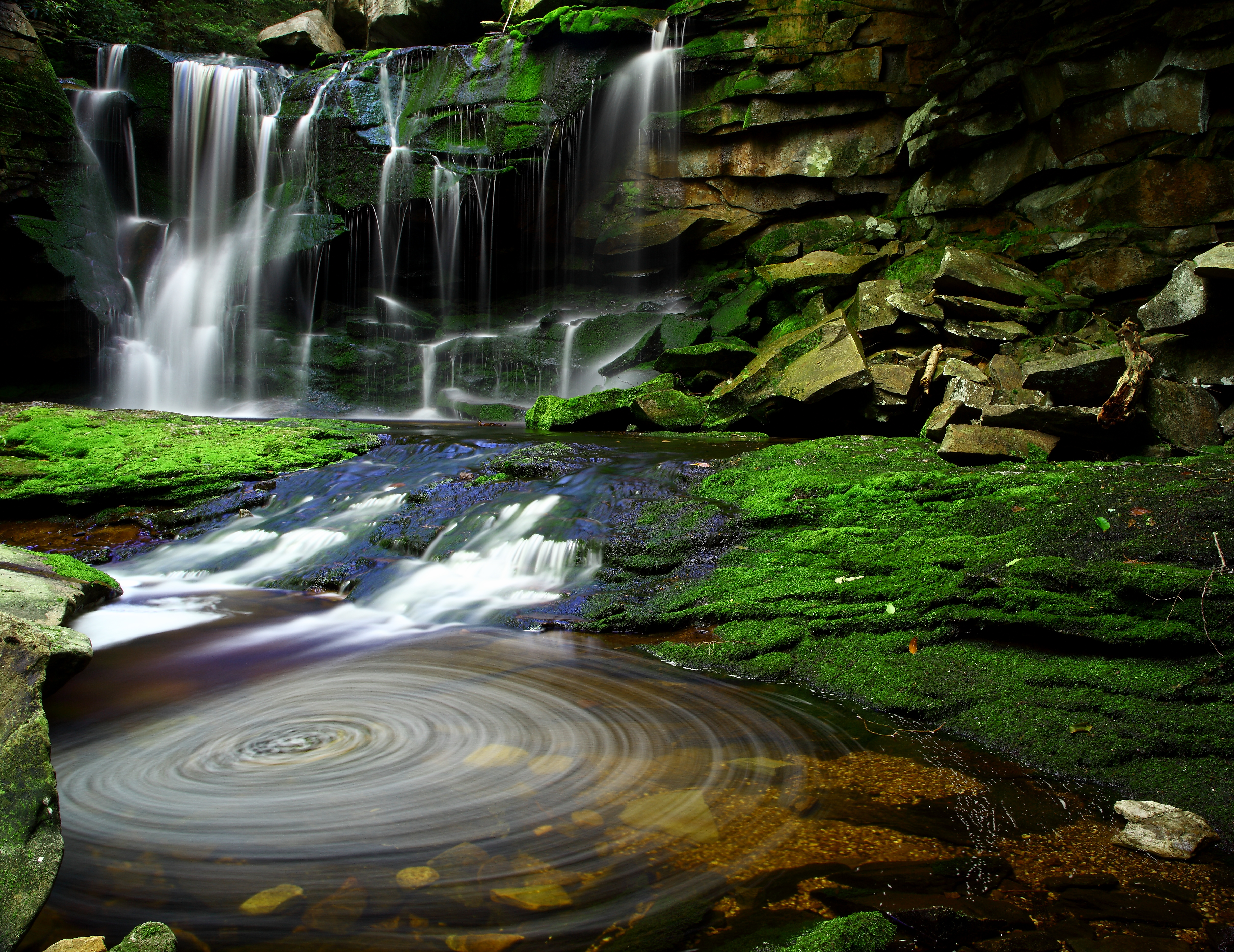Long-exposure photography on:
[Wikipedia]
[Google]
[Amazon]

 Long-exposure, time-exposure, or slow-shutter photography involves using a long-duration
Long-exposure, time-exposure, or slow-shutter photography involves using a long-duration

 While there is no fixed definition of what constitutes "long", the intent is to create a photo that somehow shows the effect of passing time, be it smoother waters or light trails. A 30-minute photo of a static object and surrounding cannot be distinguished from a short exposure; hence, the inclusion of motion is the main factor to add intrigue to long exposure photos. Images with exposure times of several minutes also tend to make moving people or dark objects disappear (because they are in any one spot for only a fraction of the exposure time), often adding a serene and otherworldly appearance to long exposure photos.
When a scene includes both stationary and moving subjects (for example, a fixed street and moving cars or a camera within a car showing a fixed dashboard and moving scenery), a slow shutter speed can cause interesting effects, such as light trails.
Long exposures are easiest to accomplish in low-light conditions but can be done in brighter light using
While there is no fixed definition of what constitutes "long", the intent is to create a photo that somehow shows the effect of passing time, be it smoother waters or light trails. A 30-minute photo of a static object and surrounding cannot be distinguished from a short exposure; hence, the inclusion of motion is the main factor to add intrigue to long exposure photos. Images with exposure times of several minutes also tend to make moving people or dark objects disappear (because they are in any one spot for only a fraction of the exposure time), often adding a serene and otherworldly appearance to long exposure photos.
When a scene includes both stationary and moving subjects (for example, a fixed street and moving cars or a camera within a car showing a fixed dashboard and moving scenery), a slow shutter speed can cause interesting effects, such as light trails.
Long exposures are easiest to accomplish in low-light conditions but can be done in brighter light using 
2012-03-14 21-42-55-file-etoiles-14f-2min-3d.jpg, alt=Short streaks of light on a dark sky, showing star trails that were photographed with a long exposure., Star trails photographed by facing northwest.
Star trails over the ESO 3.6-metre telescope.jpg, Star trails over the ESO 3.6 m Telescope.
Circumpolar Star Trails With High Flyer.jpg, A star trail photograph showing the apparent motion of stars around the north



 Long-exposure photography is often used in a night-time setting, where the lack of light forces longer exposures, if maximum quality is to be retained. Increasing ISO sensitivity allows for shorter exposures, but substantially decreases image quality through reduced dynamic range and higher noise. By leaving the camera's shutter open for an extended period of time, more light is absorbed, creating an exposure that captures the entire dynamic range of the digital camera sensor or film. If the camera is stationary for the entire period of time that the shutter is open, a very vibrant and clear photograph can be produced.
Long-exposure photography is often used in a night-time setting, where the lack of light forces longer exposures, if maximum quality is to be retained. Increasing ISO sensitivity allows for shorter exposures, but substantially decreases image quality through reduced dynamic range and higher noise. By leaving the camera's shutter open for an extended period of time, more light is absorbed, creating an exposure that captures the entire dynamic range of the digital camera sensor or film. If the camera is stationary for the entire period of time that the shutter is open, a very vibrant and clear photograph can be produced.
 Long exposures can blur moving water so it has mist-like qualities while keeping stationary objects like land and structures sharp. Varying the shutter speed can produce different effects, preserving some of the water's turbulence or smoothing it out entirely.
Long exposures can blur moving water so it has mist-like qualities while keeping stationary objects like land and structures sharp. Varying the shutter speed can produce different effects, preserving some of the water's turbulence or smoothing it out entirely.
 Solarigraphy/solargraphy is a technique in which a fixed pinhole camera is used to expose
Solarigraphy/solargraphy is a technique in which a fixed pinhole camera is used to expose
How to Take Long Exposure Landscape Photos
Article about series of solargraphs in the ESO Messenger
*
TIME IN A CAN International project of solargraphy
{{DEFAULTSORT:Long Exposure Photography Photography by genre Photographic techniques

 Long-exposure, time-exposure, or slow-shutter photography involves using a long-duration
Long-exposure, time-exposure, or slow-shutter photography involves using a long-duration shutter speed
In photography, shutter speed or exposure time is the length of time that the film or digital sensor inside the camera is exposed to light (that is, when the camera's shutter is open) when taking a photograph.
The amount of light that rea ...
to sharply capture the stationary elements of images while blurring, smearing, or obscuring the moving elements. Long-exposure photography captures one element that conventional photography does not: an extended period of time.
The paths of bright moving objects become clearly visible—clouds form broad bands, vehicle lights draw bright streaks, stars leave trails in the sky, and water waves appear smooth. Only bright objects leave visible trails, whereas dark objects usually disappear. Boats in long exposures disappear during the daytime, but draw bright trails from their lights at night.
Technique

 While there is no fixed definition of what constitutes "long", the intent is to create a photo that somehow shows the effect of passing time, be it smoother waters or light trails. A 30-minute photo of a static object and surrounding cannot be distinguished from a short exposure; hence, the inclusion of motion is the main factor to add intrigue to long exposure photos. Images with exposure times of several minutes also tend to make moving people or dark objects disappear (because they are in any one spot for only a fraction of the exposure time), often adding a serene and otherworldly appearance to long exposure photos.
When a scene includes both stationary and moving subjects (for example, a fixed street and moving cars or a camera within a car showing a fixed dashboard and moving scenery), a slow shutter speed can cause interesting effects, such as light trails.
Long exposures are easiest to accomplish in low-light conditions but can be done in brighter light using
While there is no fixed definition of what constitutes "long", the intent is to create a photo that somehow shows the effect of passing time, be it smoother waters or light trails. A 30-minute photo of a static object and surrounding cannot be distinguished from a short exposure; hence, the inclusion of motion is the main factor to add intrigue to long exposure photos. Images with exposure times of several minutes also tend to make moving people or dark objects disappear (because they are in any one spot for only a fraction of the exposure time), often adding a serene and otherworldly appearance to long exposure photos.
When a scene includes both stationary and moving subjects (for example, a fixed street and moving cars or a camera within a car showing a fixed dashboard and moving scenery), a slow shutter speed can cause interesting effects, such as light trails.
Long exposures are easiest to accomplish in low-light conditions but can be done in brighter light using neutral density filter
In photography and optics, a neutral-density filter, or ND filter, is a filter that reduces or modifies the intensity of all wavelengths, or colors, of light equally, giving no changes in hue of color rendition. It can be a colorless (clear) ...
s or specially designed cameras. When using a dense neutral density filter, a camera's auto focus will not be able to function. It is best to compose and focus without the filter. Then once one is happy with the composition, they can switch to manual focus and put the neutral density filter back on.

Applications
Star-trail photography
A star-trail photograph uses long exposure times to capture the apparent motion ofstar
A star is an astronomical object comprising a luminous spheroid of plasma (physics), plasma held together by its gravity. The List of nearest stars and brown dwarfs, nearest star to Earth is the Sun. Many other stars are visible to the naked ...
s in the night sky
The night sky is the nighttime appearance of celestial objects like stars, planets, and the Moon, which are visible in a clear sky between sunset and sunrise, when the Sun is below the horizon.
Natural light sources in a night sky in ...
due to Earth's rotation
Earth's rotation or Earth's spin is the rotation of planet Earth around its own axis, as well as changes in the orientation of the rotation axis in space. Earth rotates eastward, in prograde motion. As viewed from the northern polar star Po ...
. A star-trail photograph shows individual stars as streaks across the image, with longer exposures yielding longer arcs.
celestial pole
The north and south celestial poles are the two points in the sky where Earth's axis of rotation, indefinitely extended, intersects the celestial sphere. The north and south celestial poles appear permanently directly overhead to observers a ...
; Polaris
Polaris is a star in the northern circumpolar constellation of Ursa Minor. It is designated α Ursae Minoris ( Latinized to ''Alpha Ursae Minoris'') and is commonly called the North Star or Pole Star. With an apparent magnitude th ...
is the bright star near the pole, just above the jet trail.
The constellation of Cassiopeia over a thunderstorm.jpg, The constellation of Cassiopeia over a thunderstorm.
Startrail Feng.jpg, Startrail shot in Waterworks Prairie Park, Iowa.
Stars motion.jpg, Startrail in Fayyoum, Egypt
Egypt ( ar, مصر , ), officially the Arab Republic of Egypt, is a List of transcontinental countries, transcontinental country spanning the North Africa, northeast corner of Africa and Western Asia, southwest corner of Asia via a land bridg ...
.
Night photography



 Long-exposure photography is often used in a night-time setting, where the lack of light forces longer exposures, if maximum quality is to be retained. Increasing ISO sensitivity allows for shorter exposures, but substantially decreases image quality through reduced dynamic range and higher noise. By leaving the camera's shutter open for an extended period of time, more light is absorbed, creating an exposure that captures the entire dynamic range of the digital camera sensor or film. If the camera is stationary for the entire period of time that the shutter is open, a very vibrant and clear photograph can be produced.
Long-exposure photography is often used in a night-time setting, where the lack of light forces longer exposures, if maximum quality is to be retained. Increasing ISO sensitivity allows for shorter exposures, but substantially decreases image quality through reduced dynamic range and higher noise. By leaving the camera's shutter open for an extended period of time, more light is absorbed, creating an exposure that captures the entire dynamic range of the digital camera sensor or film. If the camera is stationary for the entire period of time that the shutter is open, a very vibrant and clear photograph can be produced.
Light painting
In this technique, a scene is kept very dark and the photographer or an assistant takes a light source—it can be small penlight—and moves it about in patterns. The light source can be turned off between strokes. Often, stationary objects in the scene are illuminated by briefly turning on studio lights, by one or more flashes from astrobe light
A strobe light or stroboscopic lamp, commonly called a strobe, is a device used to produce regular flashes of light. It is one of a number of devices that can be used as a stroboscope. The word originated from the Ancient Greek ('), meaning ...
, or by increasing the aperture
In optics, an aperture is a hole or an opening through which light travels. More specifically, the aperture and focal length of an optical system determine the cone angle of a bundle of rays that come to a focus in the image plane.
An ...
.
Water and long exposure
 Long exposures can blur moving water so it has mist-like qualities while keeping stationary objects like land and structures sharp. Varying the shutter speed can produce different effects, preserving some of the water's turbulence or smoothing it out entirely.
Long exposures can blur moving water so it has mist-like qualities while keeping stationary objects like land and structures sharp. Varying the shutter speed can produce different effects, preserving some of the water's turbulence or smoothing it out entirely.
Solarigraphy
 Solarigraphy/solargraphy is a technique in which a fixed pinhole camera is used to expose
Solarigraphy/solargraphy is a technique in which a fixed pinhole camera is used to expose photographic paper
Photographic paper is a paper coated with a light-sensitive chemical formula, like photographic film, used for making photographic prints. When photographic paper is exposed to light, it captures a latent image that is then developed to form a ...
for a length of time that is typically 6-months but can be as short as a few hours and last well over a year. Depending on the length of the exposure the resulting image shows the path of the Sun across the sky both from dawn until dusk, but also from North to South (or vice versa) between the solstices. Each light streak in a solargraphic image represents one day. Where light streaks are broken or missing indicates obstruction of the sun, which is caused by cloud cover.
Frequently, cameras are made from upcycled aluminum or tin cans which can be made light-tight and are generally weatherproof for the time needed to make the exposure. Apertures usually range in fractions of a millimeter.
One example of this is a single six-month exposure taken by photographer Justin Quinnell, showing sun-trails over Clifton Suspension Bridge
The Clifton Suspension Bridge is a suspension bridge spanning the Avon Gorge and the River Avon, linking Clifton in Bristol to Leigh Woods in North Somerset. Since opening in 1864, it has been a toll bridge, the income from which provid ...
between 19 December 2007 and 21 June 2008. Part of the ''Slow light: 6 months over Bristol'' exhibition, Quinnell describes the piece as capturing "a period of time beyond what we can perceive with our own vision." This method of solargraphy uses a simple pinhole camera
A pinhole camera is a simple camera without a lens but with a tiny aperture (the so-called '' pinhole'')—effectively a light-proof box with a small hole in one side. Light from a scene passes through the aperture and projects an inverted image ...
securely fixed in a position which won't be disturbed. Quinnel constructed his camera from an empty drink can with a 0.25mm aperture and a single sheet of photographic paper
Photographic paper is a paper coated with a light-sensitive chemical formula, like photographic film, used for making photographic prints. When photographic paper is exposed to light, it captures a latent image that is then developed to form a ...
.
See also
*Bulb (photography)
The Bulb setting (abbreviated B) on camera shutters is a momentary-action mode that holds shutters open for as long as a photographer depresses the shutter-release button. The Bulb setting is distinct from shutter's Time (T) setting, which is a ...
References
External links
How to Take Long Exposure Landscape Photos
Article about series of solargraphs in the ESO Messenger
*
TIME IN A CAN International project of solargraphy
{{DEFAULTSORT:Long Exposure Photography Photography by genre Photographic techniques